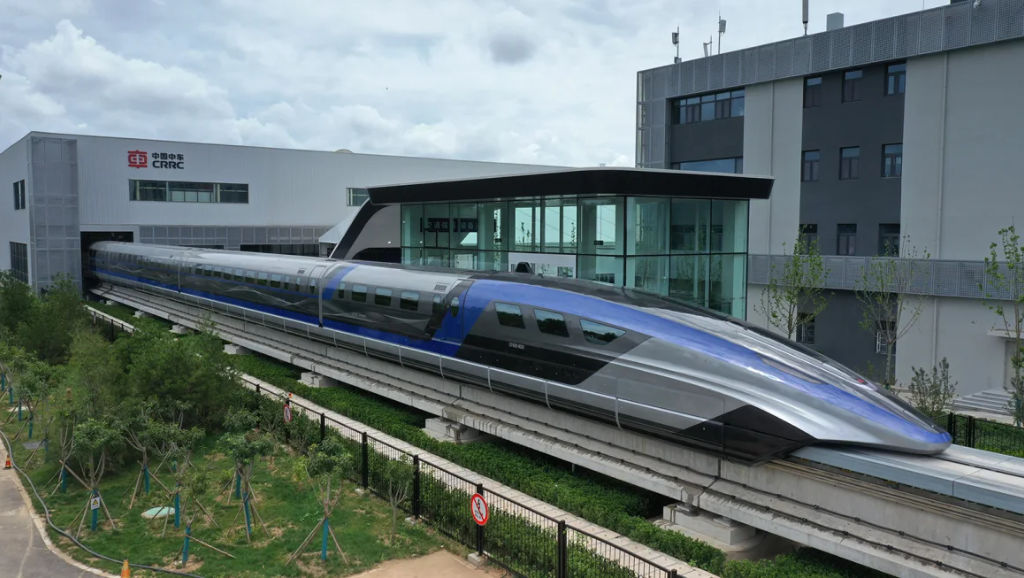Twist Levitation Technology
An experiment showing a new type of levitation

The Spanish news site La Vanguardia recently posted an interesting article about a new type of maglev (magnetic levitation) transportation technology. The article hosts an intriguing and curious picture from a very creative artist. There appears to be a gap between the artist’s rendering and the article’s content which focuses on the link to APS Physics (American Physical Society).
The experiment shows a new type of levitation implemented by rotating a magnet. The principle is simple. The result is interesting. By spinning one magnet horizontally, the other levitating magnet is perpendicular.
The principle is simple, and the media article is vague. The artist’s rendering is the still the most fascinating piece of the article. What technology application does the rendering represent? Or was the rendering an intuitive vision?
The picture provides exciting intrigue. Can the technology bring protentional maglev technology expansion? The bigger question to ask is: who is working towards developing a working prototype and is this a worthwhile technology to pursue? Can this type of technology be produced in a guideway in an efficient manner? The technology is intriguing.
What other types of maglev technology could the artist’s rendering be a reference to?
Maglev history
One of the best and most informingly accurate articles ever written about maglev is found in this link which explains the history of James Powell and the Danby - Powell maglev:
Maglev promised to be a much faster alternative to regular trains because there was no contact, and therefore no friction, between the carriages and the tracks. No friction also meant a far smoother ride than in conventional trains. In the first years after the paper’s publication, modest amounts of US federal funds were put into maglev research. But progress soon ground to a halt. The Gerald Ford administration of the mid-1970s decided to cut funding for high-speed initiatives and instead focus on improving America’s existing railroads and mass transit systems.
To the frustration of Powell and Danby, development of maglev in the US came to a near-standstill for more than a decade. In the late 1980s, hopes were briefly restored when the pair found a powerful ally in Senator Daniel Moynihan of New York, who, in a 1989 essay for Scientific American, predicted that “[maglev] will define the coming century much as the railroad defined the last one, and the automobile and airplane have defined this one.” Moynihan shepherded a bill through Congress authorizing $725 million for the development of a maglev prototype. But the funds were never appropriated by the relevant committee, which was chaired by Robert Carr, a representative from Michigan with links to the automobile industry. Since then, funding for a US maglev has been piecemeal, and Powell and Danby’s continuous efforts have seemed quixotic at times.
The Gerald Ford administration of the mid-1970s decided to cut funding for high-speed initiatives and instead focus on improving America’s existing railroads and mass transit systems.
Upon reading the near decade old article, its closing sentence begs for an analytical comment. Politics has a pattern: preserve the status-quo.
Political procedure
To those interested in conspiracy theories, Gerald Ford was an unelected President. Appointed to Vice President, eight months later became President. Prior to being appointed to Vice President, he’d worked closely with the FBI as a member of the very controversial Warren Commission.
Political procedure is maintained by entrenched lobbyists to enforce status-quo policy. This perpetuates oil interests and most importantly; transportation road infrastructure. There is a strong unwillingness to relinquish its position.
To validate James Powell’s frustration, the political climate is to maintain the status-quo at whatever the cost. Officials in elected offices are limited to conditions of compliance managed by lifetime non-elected employees. This is merely the process of government.
Maglev implementation
The initial article of Twist Levitation provides a glimpse of transportation technology potential. It’s also a reminder that the Danby and Powell’s maglev technology, patented in 1968, neglects being implemented in the US. Meanwhile Japan is implementing Danby and Powell’s fourth generation development technology.
Japan’s Chuo Shinkansen began design and testing in the 1970s. Work to build its system as the fastest train in the world began in 2010. Its initial system is to construct the line between Tokyo and Nagoya, with plans for extension to Osaka. The line is expected to connect Tokyo and Nagoya in 40 minutes, and eventually Tokyo and Osaka in 67 minutes, running at a maximum speed of 505 km/h (314 mph). About 90% of the 286-kilometer (178 mi) line to Nagoya will be tunnels. Due to environmental and social delays, the predicted completion date has been repeatedly postposed. The currently scheduled completion date for the Tokyo to Nagoya line is in 2030
.
China began building maglev transit systems in 2001 and became the world’s first commercial maglev system. It was completed in 2003 and began commercial operation in 2004. The 19-mile run from the Shanghai Airport to downtown Pudong takes eight minutes, its speed reaches 268 mph.
China is the world’s leader for technology advances in transportation. It has completed testing their sixth maglev train technology system. The significance of this test was its speed, making it the fastest train in the world at 1000 km/h (621 mph).
Transportation’s future
Science has a saying: for every action there is an equal and opposite reaction. What’s the reaction to confining energy? The reaction is synonymous to compressing the air and fuel mixture in a combustion engine. The longer Western civilization withholds and restricts the natural progression of transportation, the bigger the explosion will be to bypass its current methodology. This leads to the question: what’s next for transportation?
What’s next in transportation technology? At some point the dinosaurs cease to exist. Political procedure shifts towards modern convenience, pushed by social demand. At some point, civilization will embrace the race to space and new frontiers of exploration. This absolutely mandates efficient energy and the extinction of rocket technology.
Variations of maglev technology provide an excellent transition in efficient energy use from train and streetcar technology for transit-oriented land-use design. Available alternative transportation options with the ability to replace the convenience of the automobile for the automobile centric land-use design are still missing.
The spin magnet technology provides an ability for a stationary object to hold a spinning magnet. Is an inversion process possible? Could it be engineered for a spinning object to hold an object at rest? And how could the outer section be free to allow spin?



